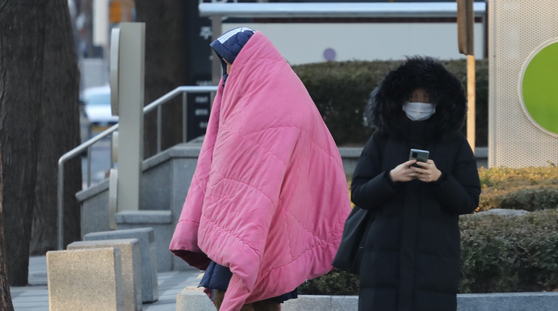
On the morning of the 8th, when the cold is coming, a citizen is passing by in downtown Seoul wearing a blanket. yunhap news
As fine dust has been cleared and a sparkling cold has arrived, a subzero cold wave is expected to continue until the morning of the 9th. The cold will be relieved from the day on the 9th.
The Meteorological Administration said, “With the cold air coming down from the northwest, the morning temperature will drop sharply until the 9th, so the northern Gyeonggi and the inland regions of Gangwon will record -10 degrees or less, and the central and southern inland areas will record less than -5 degrees.” 8 Day forecast.
In Seoul this morning, the temperature dropped to -5.4 degrees and the temperature felt very cold, approaching -10 degrees. In the northern part of Gyeonggi Province, a cold wave warning was issued as the temperature dropped near -10 degrees Celsius.
Even during the day, the chilly weather will continue with the temperature in Seoul staying at 0 degrees. The highest temperature in the daytime nationwide will show a distribution of -1 to 7 degrees Celsius.
Meanwhile, a heavy snow warning was issued as a lot of snow fell on Ulleungdo due to the influence of the cloud belt created in the East Sea. The Meteorological Administration predicted that 15 cm of snow would accumulate by this night.
On the morning of the 9th, the whole country is generally clear and the temperature in Seoul drops to -6 degrees, and the cold will continue. Nationwide, I will stay at -13~-2 degrees below zero. However, from the daytime, the warm western wind blows and the temperature will rise significantly. In Seoul, the temperature rises to 4 degrees in the middle of the day, and the whole country will record 3 to 9 degrees.
Cold and hot water winter weather… The difference in temperature in January is the largest since 1973
This year, the weather has been unusually cold and hot. According to the Meteorological Administration, the average temperature on the 8th, the lowest temperature in January, was -11.9 degrees, and the average temperature on the 23rd, the highest temperature, was 7.7 degrees. The difference in temperature between the 8th and the 23rd was 19.6 degrees, the largest since 1973, when meteorological observations were carried out nationwide.
The Korea Meteorological Administration said, “Last month, Korea’s strong convective activity in the Indian Ocean and the tropical western Pacific, along with the negative Arctic vibration to the north and La Niña to the south, confronted forces between the two Koreas.” The fluctuation was very large.”
There is a high possibility that the weather will continue in February. The Meteorological Administration predicted, “In general, there will be a higher temperature trend than normal, but there are times when it is temporarily affected by cold air, so the change in temperature will be large.”
An official from the Meteorological Administration said, “For the time being, the fluctuations in temperature will be large, so please pay special attention to health management such as lowering of immunity.”
Reporter Chun Kwon-pil [email protected]
